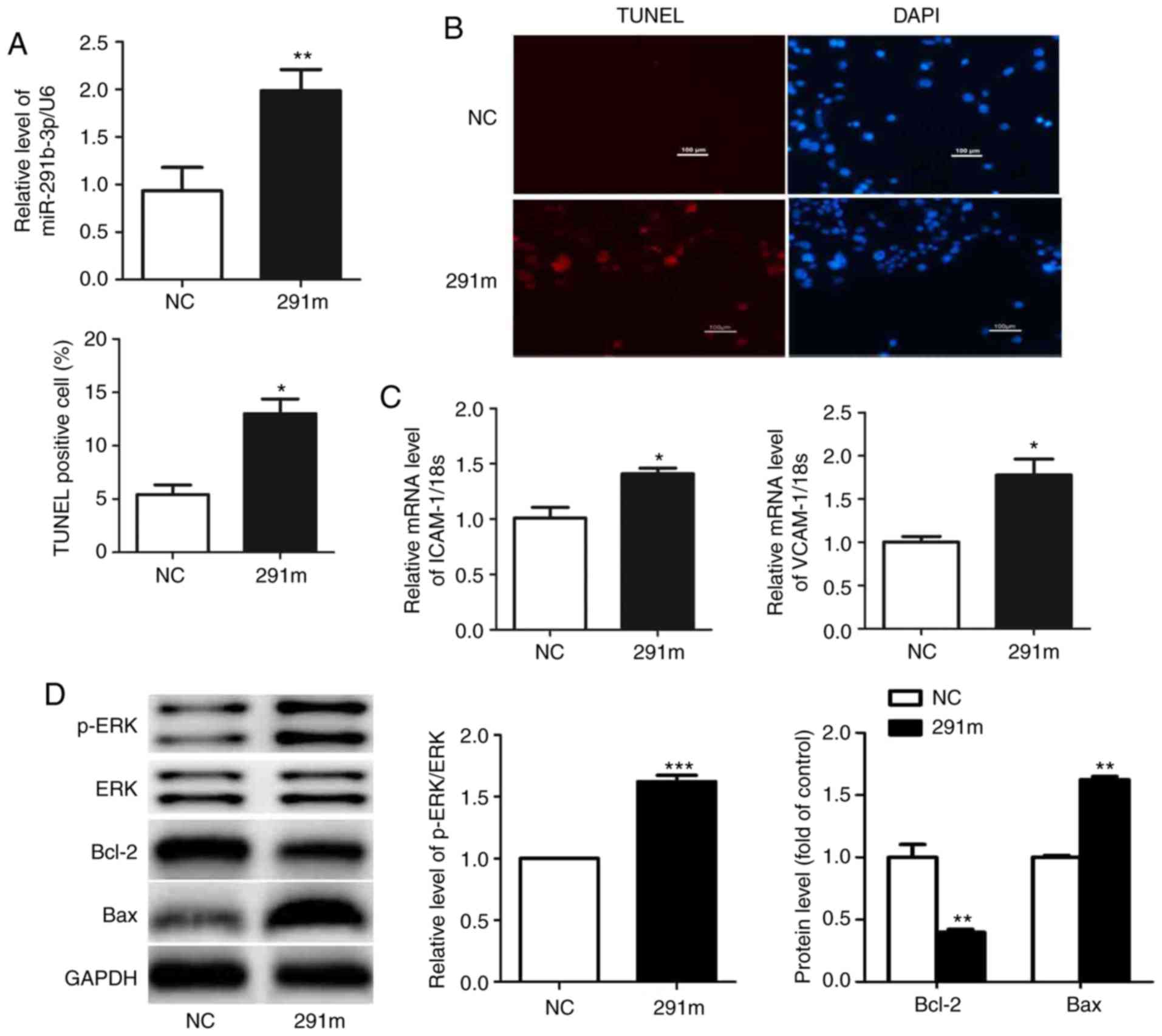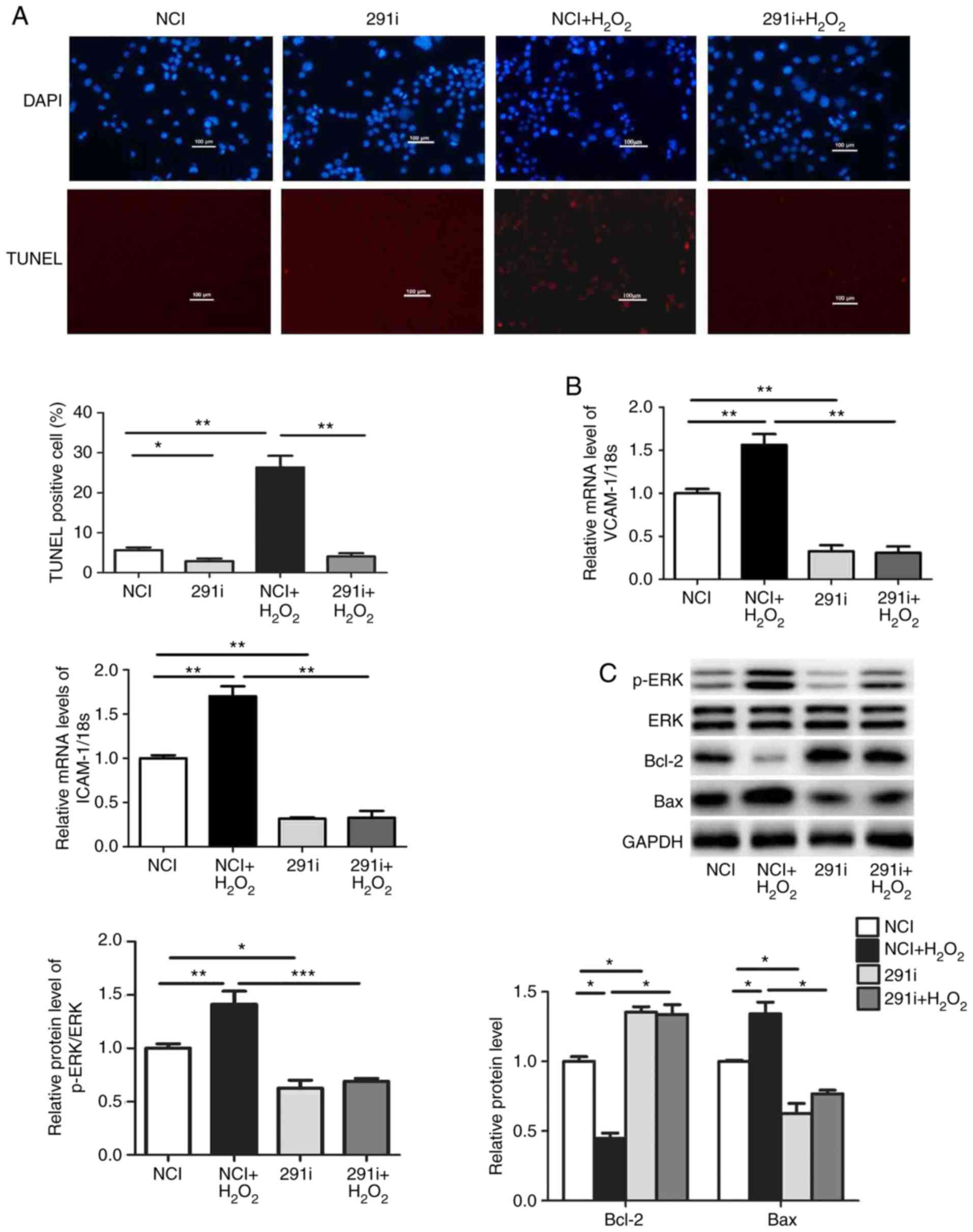|
1
|
Mannarino E and Pirro M: Molecular biology
of atherosclerosis. Clin Cases Miner Bone Metab. 5:57–62.
2008.PubMed/NCBI
|
|
2
|
Ghiadoni L, Taddei S and Virdis A:
Hypertension and endothelial dysfunction: Therapeutic approach.
Curr Vasc Pharmacol. 10:42–60. 2012. View Article : Google Scholar
|
|
3
|
Yung LM, Leung FP, Yao X, Chen ZY and
Huang Y: Reactive oxygen species in vascular wall. Cardiovasc
Hematol Disord Drug Targets. 6:1–19. 2006. View Article : Google Scholar : PubMed/NCBI
|
|
4
|
Baumgartner R, Forteza MJ and Ketelhuth
DFJ: The interplay between cytokines and the Kynurenine pathway in
inflammation and atherosclerosis. Cytokine. Sep 9–2017.(Epub ahead
of print). pii: S1043-4666(17)30259-4. 2017. View Article : Google Scholar : PubMed/NCBI
|
|
5
|
Marzolla V, Armani A, Mammi C, Moss ME,
Pagliarini V, Pontecorvo L, Antelmi A, Fabbri A, Rosano G, Jaffe IZ
and Caprio M: Essential role of ICAM-1 in aldosterone-induced
atherosclerosis. Int J Cardiol. 232:233–242. 2017. View Article : Google Scholar : PubMed/NCBI
|
|
6
|
Jang YJ, Park B, Lee HW, Park HJ, Koo HJ,
Kim BO, Sohn EH, Um SH and Pyo S: Sinigrin attenuates the
progression of atherosclerosis in ApoE- mice fed a high-cholesterol
diet potentially by inhibiting VCAM-1 expression. Chem Biol
Interact. 272:28–36. 2017. View Article : Google Scholar : PubMed/NCBI
|
|
7
|
Menghini R, Stohr R and Federici M:
MicroRNAs in vascular aging and atherosclerosis. Ageing Res Rev.
17:68–78. 2014. View Article : Google Scholar : PubMed/NCBI
|
|
8
|
Feinberg MW and Moore KJ: MicroRNA
regulation of atherosclerosis. Circ Res. 118:703–720. 2016.
View Article : Google Scholar : PubMed/NCBI
|
|
9
|
Karakas M, Schulte C, Appelbaum S, Ojeda
F, Lackner KJ, Münzel T, Schnabel RB, Blankenberg S and Zeller T:
Circulating microRNAs strongly predict cardiovascular death in
patients with coronary artery disease-results from the large
AtheroGene study. Eur Heart J. 38:516–523. 2017.
|
|
10
|
Fichtlscherer S, De Rosa S, Fox H,
Schwietz T, Fischer A, Liebetrau C, Weber M, Hamm CW, Röxe T,
Müller-Ardogan M, et al: Circulating microRNAs in patients with
coronary artery disease. Circ Res. 107:677–684. 2010. View Article : Google Scholar : PubMed/NCBI
|
|
11
|
Sun X, Icli B, Wara AK, Belkin N, He S,
Kobzik L, Hunninghake GM, Vera MP, MICU Registry, Blackwell TS,
Baron RM and Feinberg MW: MicroRNA-181b regulates NF-κB-mediated
vascular inflammation. J Clin Invest. 122:1973–1990.
2012.PubMed/NCBI
|
|
12
|
Sun X, He S, Wara AKM, Icli B, Shvartz E,
Tesmenitsky Y, Belkin N, Li D, Blackwell TS, Sukhova GK, et al:
Systemic delivery of microRNA-181b inhibits nuclear factor-κB
activation, vascular inflammation, and atherosclerosis in
apolipoprotein E-deficient mice. Circ Res. 114:32–40. 2014.
View Article : Google Scholar
|
|
13
|
Lin Y, Liu X, Cheng Y, Yang J, Huo Y and
Zhang C: Involvement of MicroRNAs in hydrogen peroxide-mediated
gene regulation and cellular injury response in vascular smooth
muscle cells. J Biol Chem. 284:7903–7913. 2009. View Article : Google Scholar : PubMed/NCBI
|
|
14
|
Zhang T, Tian F, Wang J, Jing J, Zhou SS
and Chen YD: Atherosclerosis-associated endothelial cell apoptosis
by miR-429-mediated down regulation of Bcl-2. Cell Physiol Biochem.
37:1421–1430. 2015. View Article : Google Scholar : PubMed/NCBI
|
|
15
|
Guo J, Li M, Meng X, Sui J, Dou L, Tang W,
Huang X, Man Y, Wang S and Li J: miR-291b-3p induces apoptosis in
liver cell line NCTC1469 by reducing the level of RNA-binding
protein HuR. Cell Physiol Biochem. 33:810–822. 2014. View Article : Google Scholar : PubMed/NCBI
|
|
16
|
Meng X, Guo J, Fang W, Dou L, Li M, Huang
X, Zhou S, Man Y, Tang W, Yu L and Li J: Liver MicroRNA-291b-3p
promotes hepatic lipogenesis through negative Regulation of
Adenosine 5′-Monophosphate (AMP)-activated protein kinase α1. J
Biol Chem. 291:10625–10634. 2016. View Article : Google Scholar : PubMed/NCBI
|
|
17
|
Guo J, Dou L, Meng X, Chen Z, Yang W, Fang
W, Yang C, Huang X, Tang W, Yang J and Li J: Hepatic miR-291b-3p
mediated glucose metabolism by directly targeting p65 to upregulate
PTEN expression. Sci Rep. 7:398992017. View Article : Google Scholar : PubMed/NCBI
|
|
18
|
Livak KJ and Schmittgen TD: Analysis of
relative gene expression data using real-time quantitative PCR ad
the 2(-Delta Delta C(T)) method. Methods. 25:402–408. 2001.
View Article : Google Scholar
|
|
19
|
Xu MC, Gao XF, Ruan C, Ge ZR, Lu JD, Zhang
JJ, Zhang Y, Wang L and Shi HM: miR-103 regulates oxidative stress
by targeting the BCL2/Adenovirus E1B 19 kDa interacting protein 3
in HUVECs. Oxid Med Cell Longev. 2015:4896472015. View Article : Google Scholar
|
|
20
|
Yang B, Oo TN and Rizzo V: Lipid rafts
mediate H2O2 prosurvival effects in cultured endothelial cells.
FASEB J. 20:1501–1503. 2006. View Article : Google Scholar : PubMed/NCBI
|
|
21
|
Watkin RL, Fitzpatrick GG and Kerrigan SW:
The evolving role of microRNAs in endothelial cell dysfunction in
response to infection. Semin Thromb Hemost. 44:216–223. 2018.
View Article : Google Scholar : PubMed/NCBI
|
|
22
|
Marson A, Levine SS, Cole MF, Frampton GM,
Brambrink T, Johnstone S, Guenther MG, Johnston WK, Wernig M,
Newman J, et al: Connecting microRNA genes to the core
transcriptional regulatory circuitry of embryonic stem cells. Cell.
134:521–533. 2008. View Article : Google Scholar : PubMed/NCBI
|
|
23
|
Zheng GX, Ravi A, Calabrese JM, Medeiros
LA, Kirak O, Dennis LM, Jaenisch R, Burge CB and Sharp PA: A latent
pro-survival function for the mir-290-295 cluster in mouse
embryonic stem cells. PLoS Genet. 7:e10020542011. View Article : Google Scholar : PubMed/NCBI
|
|
24
|
Hoefen RJ and Berk BC: The role of MAP
kinases in endothelial activation. Vasc Pharmacol. 38:271–273.
2002. View Article : Google Scholar
|
|
25
|
Yaman I, Fernandez J, Sarkar B, Schneider
RJ, Snider MD, Nagy LE and Hatzoglou M: Nutritional control of mRNA
stability is mediated by a conserved AU-rich element that binds the
cytoplasmic shuttling protein HuR. J Biol Chem. 277:41539–41546.
2002. View Article : Google Scholar : PubMed/NCBI
|
|
26
|
Sharma S, Verma S, Vasudevan M, Samanta S,
Thakur JK and Kulshreshtha R: The interplay of HuR and miR-3134 in
regulation of AU rich transcriptome. RNA Biol. 10:1283–1290. 2013.
View Article : Google Scholar : PubMed/NCBI
|
|
27
|
Chen CY, Xu N and Shyu AB: Highly
selective actions of HuR in antagonizing AU-rich element-mediated
mRNA destabilization. Mol Cell Biol. 22:7268–7278. 2002. View Article : Google Scholar : PubMed/NCBI
|
|
28
|
Wang W, Furneaux H, Cheng H, Caldwell MC,
Hutter D, Liu Y, Holbrook N and Gorospe M: HuR regulates p21 mRNA
stabilization by UV light. Mol Cell Biol. 20:760–769. 2000.
View Article : Google Scholar : PubMed/NCBI
|
|
29
|
Kim GY, Lim SJ and Kim YW: Expression of
HuR, COX-2, and survivin in lung cancers; cytoplasmic HuR
stabilizes cyclooxygenase-2 in squamous cell carcinomas. Mod
Pathol. 24:1336–1347. 2011. View Article : Google Scholar : PubMed/NCBI
|
|
30
|
Yuan Z, Sanders AJ, Ye L, Wang Y and Jiang
WG: Knockdown of human antigen R reduces the growth and invasion of
breast cancer cells in vitro and affects expression of cyclin D1
and MMP-9. Oncol Rep. 26:237–245. 2011.PubMed/NCBI
|
|
31
|
Nabors LB, Suswam E, Huang Y, Yang X,
Johnson MJ and King PH: Tumor necrosis factor alpha induces
angiogenic factor up-regulation in malignant glioma cells: A role
for RNA stabilization and HuR. Cancer Res. 63:4181–4187.
2003.PubMed/NCBI
|
|
32
|
Talwar S, Jin J, Carroll B, Liu A,
Gillespie MB and Palanisamy V: Caspase-mediated cleavage of
RNA-binding protein HuR regulates c-Myc protein expression after
hypoxic stress. J Biol Chem. 286:32333–32343. 2011. View Article : Google Scholar : PubMed/NCBI
|
|
33
|
Kullmann M, Göpfert U, Siewe B and Hengst
L: ELAV/Hu proteins inhibit p27 translation via an IRES element in
the p27 5′UTR. Genes Dev. 16:3087–3099. 2002. View Article : Google Scholar : PubMed/NCBI
|














